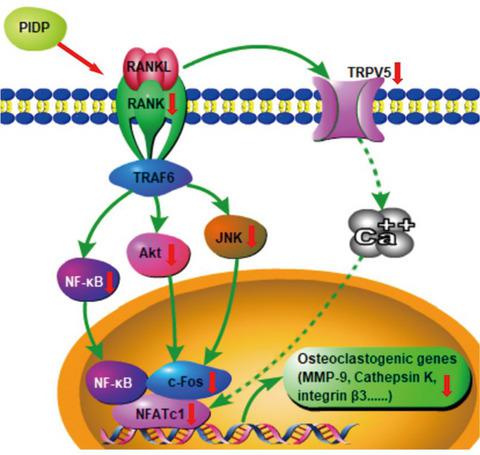当前位置:
X-MOL 学术
›
Chem. Bio. Drug Des.
›
论文详情
Our official English website, www.x-mol.net, welcomes your
feedback! (Note: you will need to create a separate account there.)
Pharmacological evaluation of imidazole-derived bisphosphonates on receptor activator of nuclear factor-κB ligand-induced osteoclast differentiation and function.
Chemical Biology & Drug Design ( IF 3.2 ) Pub Date : 2020-07-31 , DOI: 10.1111/cbdd.13767 Jianguo Lin 1, 2 , Ying Peng 1 , Qingzhu Liu 1 , Ke Li 1 , Gaochao Lv 1 , Yann Seimbille 3 , Gang Huang 4 , Feng Gao 5 , Ling Qiu 1, 2
Chemical Biology & Drug Design ( IF 3.2 ) Pub Date : 2020-07-31 , DOI: 10.1111/cbdd.13767 Jianguo Lin 1, 2 , Ying Peng 1 , Qingzhu Liu 1 , Ke Li 1 , Gaochao Lv 1 , Yann Seimbille 3 , Gang Huang 4 , Feng Gao 5 , Ling Qiu 1, 2
Affiliation

|
Bisphosphonates (BPs) have been commonly used in the treatment of osteolytic bone lesions, such as osteoporosis and osteogenesis imperfecta. However, serious side‐effects can occur during the therapy. To search for novel potent BPs with lower side‐effects, a series of imidazole‐containing BPs (zoledronic acid [ZOL]; ZOL derivatives by substitution of the hydrogen at the 2‐position on the imidazole ring with a methyl [MIDP], ethyl [EIDP], n‐propyl [PIDP], or n‐butyl group [BIDP]) were developed and the effects on receptor activator of nuclear factor‐κB ligand (RANKL)‐induced osteoclast differentiation were investigated using the murine macrophage RAW 264.7 cells at the protein, gene, and morphological and functional levels. Influences of these BPs on the cell growth and proliferation of RAW 264.7 were also studied in order to determine cytotoxicity. The results showed that PIDP significantly inhibited the RANKL‐induced osteoclast formation in a dose‐dependent fashion without inducing cytotoxicity under the concentration of 12.5 μM. It exerted remarkable suppressive effects on the development of actin rings, the bone resorption, and the expressions of osteoclastogenesis‐related gene and protein markers. The down‐regulation of c‐Jun N‐terminal kinase (JNK), protein kinase B (Akt), and inhibitor of nuclear factor kappa‐B (IκB) phosphorylation in the early signaling event and subsequent inhibition of the expression of c‐Fos and nuclear factor of activated T cells (NFATc1) might be involved in these effects. All these results indicated that PIDP might be a promising drug to treat bone‐related disorders.
中文翻译:

咪唑衍生的双膦酸盐对核因子-κB 配体诱导的破骨细胞分化和功能的受体激活剂的药理学评价。
双膦酸盐(BPs)已被广泛用于治疗溶骨性骨病变,如骨质疏松症和成骨不全症。然而,在治疗过程中可能会出现严重的副作用。为了寻找具有较低副作用的新型强效 BP,一系列含咪唑的 BP(唑来膦酸 [ZOL];通过用甲基 [MIDP]、乙基取代咪唑环上的 2 位氢的 ZOL 衍生物[EIDP]、正丙基 [PIDP] 或n丁基基团 [BIDP]) 被开发出来,并使用鼠巨噬细胞 RAW 264.7 细胞在蛋白质、基因、形态和功能水平上研究了对核因子-κB 配体 (RANKL) 诱导的破骨细胞分化的受体激活剂的影响。还研究了这些 BP 对 RAW 264.7 细胞生长和增殖的影响,以确定细胞毒性。结果表明,PIDP 在 12.5 μM 的浓度下以剂量依赖性方式显着抑制 RANKL 诱导的破骨细胞形成,而不会引起细胞毒性。它对肌动蛋白环的形成、骨吸收以及破骨细胞生成相关基因和蛋白质标志物的表达具有显着的抑制作用。c-Jun N 端激酶 (JNK)、蛋白激酶 B (Akt) 的下调,早期信号事件中核因子 kappa-B (IκB) 磷酸化的抑制剂和随后对 c-Fos 和活化 T 细胞核因子 (NFATc1) 表达的抑制可能与这些影响有关。所有这些结果表明,PIDP 可能是一种治疗骨相关疾病的有前途的药物。
更新日期:2020-07-31
中文翻译:

咪唑衍生的双膦酸盐对核因子-κB 配体诱导的破骨细胞分化和功能的受体激活剂的药理学评价。
双膦酸盐(BPs)已被广泛用于治疗溶骨性骨病变,如骨质疏松症和成骨不全症。然而,在治疗过程中可能会出现严重的副作用。为了寻找具有较低副作用的新型强效 BP,一系列含咪唑的 BP(唑来膦酸 [ZOL];通过用甲基 [MIDP]、乙基取代咪唑环上的 2 位氢的 ZOL 衍生物[EIDP]、正丙基 [PIDP] 或n丁基基团 [BIDP]) 被开发出来,并使用鼠巨噬细胞 RAW 264.7 细胞在蛋白质、基因、形态和功能水平上研究了对核因子-κB 配体 (RANKL) 诱导的破骨细胞分化的受体激活剂的影响。还研究了这些 BP 对 RAW 264.7 细胞生长和增殖的影响,以确定细胞毒性。结果表明,PIDP 在 12.5 μM 的浓度下以剂量依赖性方式显着抑制 RANKL 诱导的破骨细胞形成,而不会引起细胞毒性。它对肌动蛋白环的形成、骨吸收以及破骨细胞生成相关基因和蛋白质标志物的表达具有显着的抑制作用。c-Jun N 端激酶 (JNK)、蛋白激酶 B (Akt) 的下调,早期信号事件中核因子 kappa-B (IκB) 磷酸化的抑制剂和随后对 c-Fos 和活化 T 细胞核因子 (NFATc1) 表达的抑制可能与这些影响有关。所有这些结果表明,PIDP 可能是一种治疗骨相关疾病的有前途的药物。











































 京公网安备 11010802027423号
京公网安备 11010802027423号